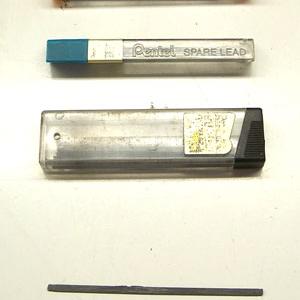College of Liberal Arts & Sciences
5D10.16 - Resistors - Characteristics of Pencil Lead Resistors
Pencil lines drawn onto paper, or pencil lead can be used as resistors and in particular used for studies of cross sections. One set of leads in the box have one lead sanded so that its cross section is 1/2 of the other. Pencil leads of different diameters may also be obtained for the same demonstration.
- Vibhooti Shekhawat, "Graphite-Paper Circuit Elements: Resistor, Capacitor, and ¶ Value Estimation", TPT, Vol. 61, #2, Feb. 2023, p. 154.
- Ricardo Medel-Esquivel, Isidro Gomez-Vargas, Ricardo Garcia-Salcedo, J. Alberto Vazquez, "A Simple Estimation of the Size of Carbon Atoms Using a Pencil Lead", TPT, Vol. 59, #6, Sept. 2021, p. 480.
- Asuman Kucukozer, "Teaching the Factors Affecting Resistance Using Pencil Leads", TPT, Vol. 53, # 1, Jan. 2015, p. 38.
- Chris Chiaverina, "Exploring Electric Circuits and Resistance Using Pencil Lead", TPT, Vol. 52, # 9, Dec. 2014, p. 570.
- Samuel Derman and Aron Goykadosh, "A Pencil-and-Tape Electricity Experiment", TPT, Vol. 37, #7, Oct. 1999, p. 400.
- Bobby Mercer, "Pencil Lead Lightbulb", Junk Drawer Physics, p. 142.
- Rudolf F. Graf, "Controlling Your Current", Safe and Simple Electrical Experiments, p. 102.
- Borislaw Bilash II, “Group 14: Metals versus Nonmetals“, A Demo A Day – A Year of Physical Science Demonstrations, p. 136.
Disclaimer: These demonstrations are provided only for illustrative use by persons affiliated with The University of Iowa and only under the direction of a trained instructor or physicist. The University of Iowa is not responsible for demonstrations performed by those using their own equipment or who choose to use this reference material for their own purpose. The demonstrations included here are within the public domain and can be found in materials contained in libraries, bookstores, and through electronic sources. Performing all or any portion of any of these demonstrations, with or without revisions not depicted here entails inherent risks. These risks include, without limitation, bodily injury (and possibly death), including risks to health that may be temporary or permanent and that may exacerbate a pre-existing medical condition; and property loss or damage. Anyone performing any part of these demonstrations, even with revisions, knowingly and voluntarily assumes all risks associated with them.
